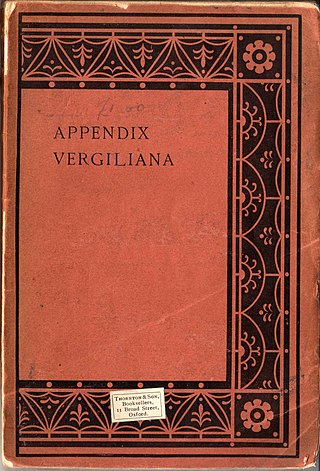
Publius Vergilius Maro, usually called Virgil or Vergil in English, was an ancient Roman poet of the Augustan period. He composed three of the most famous poems in Latin literature: the Eclogues, the Georgics, and the epic Aeneid. A number of minor poems, collected in the Appendix Vergiliana, were attributed to him in ancient times, but modern scholars consider his authorship of these poems to be dubious.

Proserpina or Proserpine is an ancient Roman goddess whose iconography, functions and myths are virtually identical to those of Greek Persephone. Proserpina replaced or was combined with the ancient Roman fertility goddess Libera, whose principal cult was housed in the Aventine temple of the grain-goddess Ceres, along with the wine god Liber.
Aegle is the name of several different figures in Greek mythology:

In Greek mythology, Cyparissus or Kyparissos was a boy beloved by Apollo or in some versions by other deities. In the best-known version of the story, the favorite companion of Cyparissus was a tamed stag, which he accidentally killed with his hunting javelin as it lay sleeping in the woods. The boy's grief was such that it transformed him into a cypress tree, a classical symbol of mourning. The myth is thus aetiological in explaining the relation of the tree to its cultural significance. The subject is mainly known from Hellenized Latin literature and frescoes from Pompeii. No Greek hero cult devoted to Cyparissus has been identified.

In Greek mythology and religion, Themis is the goddess and personification of justice, divine order, law, and custom. She is one of the twelve Titan children of Gaia and Uranus, and the second wife of Zeus. She is associated with oracles and prophecies, including the Oracle of Delphi. Her symbol is the Scales of Justice.
In Greek mythology, the Crinaeae were a type of Naiad nymphs associated with fountains or wells.

Silvanus was a Roman tutelary deity of woods and uncultivated lands. As protector of the forest, he especially presided over plantations and delighted in trees growing wild. He is also described as a god watching over the fields and husbandmen, protecting in particular the boundaries of fields. The similarly named Etruscan deity Selvans may be a borrowing of Silvanus, or not even related in origin.

In Roman mythology and ancient religion, Clementia is the goddess of clemency, leniency, mercy, forgiveness, penance, redemption, absolution, acquittal and salvation.

The Georgics is a poem by Latin poet Virgil, likely published in 29 BCE. As the name suggests the subject of the poem is agriculture; but far from being an example of peaceful rural poetry, it is a work characterized by tensions in both theme and purpose.

The Appendix Vergiliana is a collection of Latin poems traditionally ascribed as being the juvenilia of Virgil.

In ancient Roman religion and magic, the fascinus or fascinum was the embodiment of the divine phallus. The word can refer to phallus effigies and amulets, and to the spells used to invoke his divine protection. Pliny calls it a medicus invidiae, a "doctor" or remedy for envy or the evil eye.

Medicamina Faciei Femineae is a didactic poem written in elegiac couplets by the Roman poet Ovid. In the hundred extant verses, Ovid defends the use of cosmetics by Roman women and provides five recipes for facial treatments. Other writers at the time condemned women's usage of cosmetics.

In classical mythology, Cupid is the god of desire, erotic love, attraction and affection. He is often portrayed as the son of the love goddess Venus and the god of war Mars. He is also known as Amor. His Greek counterpart is Eros. Although Eros is generally portrayed as a slender winged youth in Classical Greek art, during the Hellenistic period, he was increasingly portrayed as a chubby boy. During this time, his iconography acquired the bow and arrow that represent his source of power: a person, or even a deity, who is shot by Cupid's arrow is filled with uncontrollable desire. In myths, Cupid is a minor character who serves mostly to set the plot in motion. He is a main character only in the tale of Cupid and Psyche, when wounded by his own weapons, he experiences the ordeal of love. Although other extended stories are not told about him, his tradition is rich in poetic themes and visual scenarios, such as "Love conquers all" and the retaliatory punishment or torture of Cupid.
In ancient Athens, Eleos or Elea was the personification of mercy, clemency, compassion and pity – the counterpart of the Roman goddess Clementia. Pausanias described her as "among all the gods the most useful to human life in all its vicissitudes."
In Greek mythology, Oaxes or Oaxos was the founder of the town of Oaxus within Crete, a place known to Servius and Herodotus. He was the son of the god Apollo either by the Cretan nymph Anchiale or Acacallis, daughter of Minos. Apollonius wrote in Argonautica of Crete being the Oaxian land. Vibius Sequester wrote the river Oaxes gave its name. The river Oaxes was, according to Baudrand, very cold.
Anser was a minor poet of ancient Rome who lived in the 1st century BC. He is mentioned by Ovid as a writer of love poetry associated with Catullus, Calvus and Cinna. According to the 4th-century AD grammarian Servius, he was a "very bad poet" who wrote in praise of the triumvir Mark Antony and was a detractor of Virgil. None of his work is known to have survived.
In Greek mythology, Hesperia or Hesperie, may refer to the following characters and places:

In Greek mythology, Aganippe was the name of both a spring and the Naiad associated with it. The spring is in Boeotia, near Thespiae, at the base of Mount Helicon, and was associated with the Muses who were sometimes called Aganippides. Drinking from her well, it was considered to be a source of poetic inspiration. The nymph is called a daughter of the river-god Permessus. Ovid associates Aganippe with Hippocrene.














